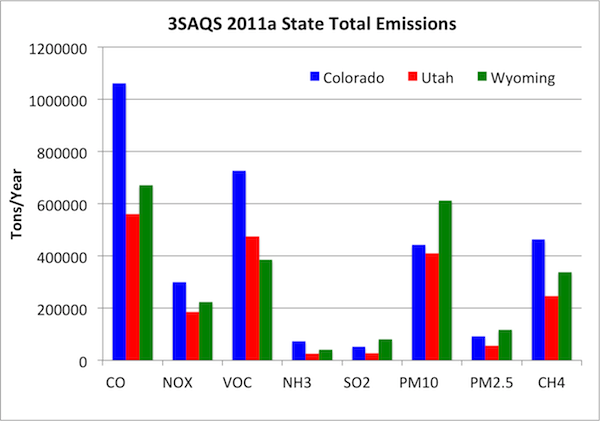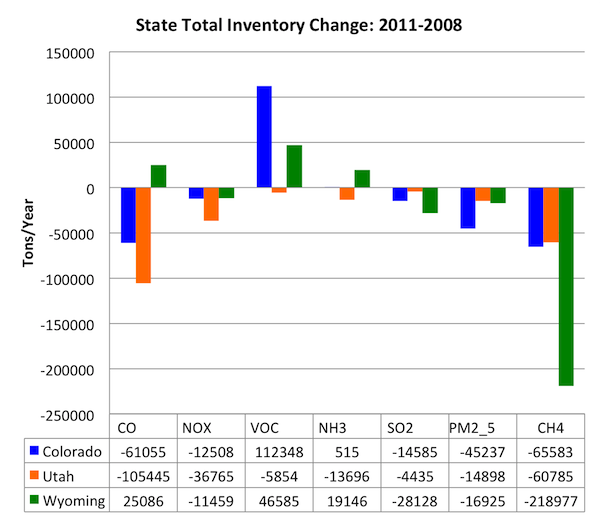SMOKE 2011a Emissions
Introduction
The 3SAQS used the Sparse Matrix Operator Kernel Emissions (SMOKE) processing system version 3.5.1 to prepare emissions inputs for photochemical grid models (PGMs). The 3SAQS 2011 emissions modeling platform consists of data and software to estimate air emissions fluxes that best represent the conditions in the 3SAQS modeling domain during 2011. The base 2011 modeling period is annual, and included a model spin-up period from December 16 to December 31, 2011. The modeling domain includes a 36 km continental US (CONUS) domain with a 12 km nest over the western U.S. and a 4-km nest the covers the states of Colorado, Utah, and Wyoming.
The following sectors were used to represent air pollutant emissions for the 3SAQS:
- Aircraft/locomotive/marine (ALM)
- Off-road mobile (Nonroad)
- On-road mobile (Onroad)
- Non-point/Area (Nonpoint)
- Fugitive Dust
- Fertilizer
- Livestock
- Residential Wood Combustion (RWC)
- Area oil and gas (Area O&G)
- Point oil and gas (Point O&G)
- Continuous Emission Monitor (CEM) point (EGU Point)
- Non-CEM point (NonEGU Point)
- Offshore shipping (Offshore)
- Fires (Fire)
- Canada and Mexico sources (Non-US)
- MEGAN biogenics (Biogenic)
- Windblown dust (WBD)
- Sea salt
- Lightning
Details of the sources and nature of these emissions data are provided in the 3SAQS 2011 Modeling Protocol.
Results
2011 version A results2011 three-state total emissions, inventory sector totals, and comparisons to the other 3SAQS modeling platforms are presented here. On a state total basis Colorado has the highest 2011 emissions of CO, NOx, VOC, NH3, and methane (CH4) of the three states. Wyoming has the highest 2011 emissions of SO2 and PM species.

The following table includes plots that breakdown the 2011 3SAQS emissions for each inventory pollutant by sector and monthly total spatial plots on the 3SAQS 4-km modeling domain.
The high resolution maps presented here are designed to inform air quality model performance. The include the following layers:
- Pie charts showing the magnitude (size of the pie) and distribution of the county-level emissions by inventory sector.
- County boundaries with county names
- Air quality monitors with the monitor station ID
- Active oil and gas wells as of January 2015
- Class I areas
- Federal lands by managing agency
Colorado: NOx, VOC, NH3, SO2, PM2.5, POC
Utah: NOx, VOC, NH3, SO2, PM2.5, POC
Wyoming: NOx, VOC, NH3, SO2, PM2.5, POC
Comparisons to 2008
 |  |
- Carbon Monoxide
- Nitrogen Oxides
- Volatile Organic Compounds
- Ammonia
- Sulfur Dioxide
- Fine Particulate Matter
- Methane
Residential Wood Combustion Sources
The model performance evaluation of CAMx simulation Base11a reveals significant positive biases (over-estimates) of organic carbon (OC) fine particulate matter (PM2.5) at urban monitors. OC has both primary and secondary sources, which will both need to be investigated to determine the cause of the poor model performance.
Residential wood combustion sources (e.g. wood furnaces, fireplaces, and wood stoves) are the largest sources of primary OC in the proximity of the monitors with the worst model performance in 3SAQS simulation Base11a.